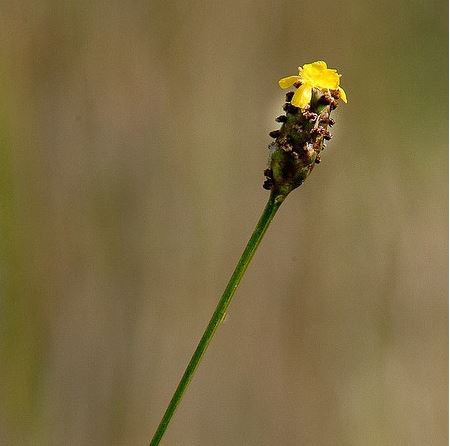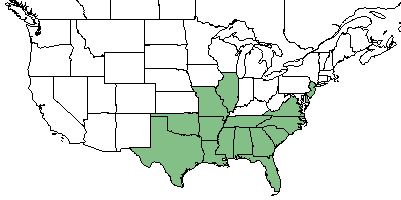Difference between revisions of "Xyris jupicai"
(→Ecology) |
Juliec4335 (talk | contribs) |
||
| Line 36: | Line 36: | ||
This species grows in a range of soil types that are predominantly sandy (sandy peat, sandy clay, etc.). It can grow in dry soils, but it is typically found in wet soils such as those at lake margins <ref name="herb"/>. | This species grows in a range of soil types that are predominantly sandy (sandy peat, sandy clay, etc.). It can grow in dry soils, but it is typically found in wet soils such as those at lake margins <ref name="herb"/>. | ||
| − | Associated species- ''X. jupicai'' has been found with the following genera: ''Lycopodium'', ''Drosera'', ''Ludwigia'', ''Scleria'', ''Polygonum'', ''Andropogon'', ''Rhynchospora'', ''Juncus'', ''Polygala'', ''Pontederia'', ''Sagittaria'', ''Psilocarya'', ''Eriocaulon'',''Ilex'' and ''Eleocharis'' and the following species: ''Fimbristylis autumnalis'', ''Fuirena scirpoidea'', ''Eleocharis olivacea'', ''Xyris caroliniana'', ''X elliottii'', ''X. fimbriata'', ''X. longisepala'', ''Eriocaulon lineare'', ''Rhexia salicifolia'', ''Rhexia virginica'', '' Panicum verrucosum'', ''Eragrostis refracta'', ''Juncus abortivus'', ''J. megacephalus'', ''J. debilis'', ''Lachnanthes caroliniana'', ''Erigeron vernus'', ''Ludwigia linearis'', ''Hypericum fasciculatum'', ''Ilex myrtofolia'', ''Nyssa biflora'', Turkey Oak and Loblolly pine <ref name="herb"/>. | + | Associated species- ''X. jupicai'' has been found with the following genera: ''Lycopodium'', ''Drosera'', ''Ludwigia'', ''Scleria'', ''Polygonum'', ''Andropogon'', ''Rhynchospora'', ''Juncus'', ''Polygala'', ''Pontederia'', ''Sagittaria'', ''Psilocarya'', ''Eriocaulon'',''Ilex'' and ''Eleocharis'' and the following species: ''Fimbristylis autumnalis'', ''Fuirena scirpoidea'', ''Eleocharis olivacea'', ''Xyris caroliniana'', ''X elliottii'', ''X. fimbriata'', ''X. longisepala'', ''Eriocaulon lineare'', ''Rhexia salicifolia'', ''Rhexia virginica'', '' Panicum verrucosum'', ''Eragrostis refracta'', ''Juncus abortivus'', ''J. megacephalus'', ''J. debilis'', ''Lachnanthes caroliniana'', ''Erigeron vernus'', ''Ludwigia linearis'', ''Hypericum fasciculatum'', ''Ilex myrtofolia'', ''Nyssa biflora'', Turkey Oak and Loblolly pine <ref name="herb"/>. |
| + | |||
| + | ''Xyris jupicai'' is an indicator species for the Calcareous Savannas community type as described in Carr et al. (2010).<ref>Carr, S.C., K.M. Robertson, and R.K. Peet. 2010. A vegetation classification of fire-dependent pinelands of Florida. Castanea 75:153-189.</ref> | ||
===Phenology=== <!--Timing off flowering, fruiting, seed dispersal, and environmental triggers. Cite PanFlora website if appropriate: http://www.gilnelson.com/PanFlora/ --> | ===Phenology=== <!--Timing off flowering, fruiting, seed dispersal, and environmental triggers. Cite PanFlora website if appropriate: http://www.gilnelson.com/PanFlora/ --> | ||
Revision as of 22:55, 23 July 2020
Common names: Richard's yelloweyed grass
| Xyris jupicai | |
|---|---|

| |
| Photo by John Bradford hosted at Bluemelon.com/poaceae | |
| Scientific classification | |
| Kingdom: | Plantae |
| Division: | Magnoliophyta - Flowering plants |
| Class: | Liliopsida - Moncots |
| Order: | Commelinales |
| Family: | Xyridaceae |
| Genus: | Xyris |
| Species: | X. jupicai |
| Binomial name | |
| Xyris jupicai Kunth | |

| |
| Natural range of Xyris jupicai from USDA NRCS Plants Database. | |
Contents
Taxonomic Notes
Synonyms: X. caroliniana, X. elata Chapman, X. communis Kunth
Varieties: none
Description
X. jupicai is a monocot forb in the Xyridaceae family that can be either an annual or perennial [1]. Individual plants are solitary or can be found in small tufts that arise from lateral offshoots. Leaves are linear, 10-60 cm. long and 5-10 mm. wide. They are described as "flat to slightly twisted, ascending, smooth to minutely tuberculate along the margins; tip acute; equitant portion gradually broadened to the slightly dilated, yellowish-preen or tan base" [2].
Distribution
It is native throughout the southeast United States, particularly widespread throughout Florida and along the southeast coast to southern New Jersey [1].
Ecology
Habitat
X. jupicai is wetland obligate[1]. S such, it can be found in areas such as "wet sands or sandy peat or roadside ditches, flatwoods pond margins, cypress swamps, and lake shores" [2]. It has also been found in disturbed areas such as roadsides, cleared pine flats, and farms[3]. This species grows in a range of soil types that are predominantly sandy (sandy peat, sandy clay, etc.). It can grow in dry soils, but it is typically found in wet soils such as those at lake margins [3].
Associated species- X. jupicai has been found with the following genera: Lycopodium, Drosera, Ludwigia, Scleria, Polygonum, Andropogon, Rhynchospora, Juncus, Polygala, Pontederia, Sagittaria, Psilocarya, Eriocaulon,Ilex and Eleocharis and the following species: Fimbristylis autumnalis, Fuirena scirpoidea, Eleocharis olivacea, Xyris caroliniana, X elliottii, X. fimbriata, X. longisepala, Eriocaulon lineare, Rhexia salicifolia, Rhexia virginica, Panicum verrucosum, Eragrostis refracta, Juncus abortivus, J. megacephalus, J. debilis, Lachnanthes caroliniana, Erigeron vernus, Ludwigia linearis, Hypericum fasciculatum, Ilex myrtofolia, Nyssa biflora, Turkey Oak and Loblolly pine [3].
Xyris jupicai is an indicator species for the Calcareous Savannas community type as described in Carr et al. (2010).[4]
Phenology
This species typically flowers from July through September [5]. It fruits from July to mid-November [3].
Conservation and Management
Cultivation and restoration
Photo Gallery
References and notes
- ↑ 1.0 1.1 1.2 USDA Plants Database: https://plants.usda.gov/core/profile?symbol=XYJU
- ↑ 2.0 2.1 Kral, R. (1960). "The genus Xyris in Florida." Rhodora 62(743): 295-319.
- ↑ 3.0 3.1 3.2 3.3 Florida State University Robert K. Godfrey Herbarium database. URL: http://herbarium.bio.fsu.edu. Last accessed: June 2014. Collectors: Robert K. Godfrey, Loran C. Anderson, Wilson Baker, Ann Johnson, R.F. Doren, Steve L. Orzell, Rodie White, R. Komarek, R. Kral, A. H. Curtiss, Bruce Hansen, JoAnn Hansen, Robert L. Lazor, Edwin L. Bridges, O. Lakela, A. F. Clewell, Robt. Blaisdell, Chas. C. Deam, Gary R. Knight, Grady W. Reinert, Edwin L. Tyson, Manuel Rimachi, C. Nelson, Thomas E. Miller, Lisa Keppner, Sidney McDaniel, Kathleen Craddock Burks, David Hall, Gary Schultz, Richard D. Houk, P. L. Redfearn, J. D. Freeman, L. Dalrymple, A. B. Pittman, A. R. Darr, K. Boyle, Charles T. Bryson, Samuel B. Jones, J. Stutts, A. Gholson, W. H. Hodge, H. L. Blomquist, R. B. Channell, Hollis J. Rogers, B. C. Tharp, Fred A. Barkley, Wilbur H. Duncan, James W. Hardin, Harry E. Ahles, J. A. Duke and Cindi Stewart. States and Counties: Alabama: Barbour, Montgomery and Sumter. Arkansas: Calhoun and Union. Florida: Baker, Bay, Brevard, Calhoun, Citrus, Clay, Collier, Escambia, Franklin, Gilchrist, Gulf, Hamilton, Hernando, Highlands, Hillsborough, Holmes, Indian River, Jackson, Jefferson, Leon, Levy, Liberty, Madison, Okaloosa, Orange, Palm Beach, Pasco, Polk, Santa Rosa, Sarasota, Taylor, Wakulla and Washington. Georgia: Appling, Baker, Brooks, Charlton, Echols, Elbert, Grady and Seminole. Louisiana: Beauregard, Claiborne, Lincoln and Union. Mississippi: Greene, Lafayette and Lamar. North Carolina: Beaufort, Brunswick, Carteret, Columbus, Currituck, Dublin and Onslow. South Carolina: Bamberg. Texas: Gonzales, Marion, Polk and Robertson. Virginia: Suffolk City.
- ↑ Carr, S.C., K.M. Robertson, and R.K. Peet. 2010. A vegetation classification of fire-dependent pinelands of Florida. Castanea 75:153-189.
- ↑ Weakley, A. S. (2015). Flora of the Southern and Mid-Atlantic States. Chapel Hill, NC, University of North Carolina Herbarium.